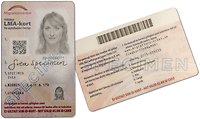Applying for asylum
At your first meeting with the Swedish Migration Agency, you will answer many questions, you will receive information about the asylum process, and you can also get help to call your parents or other relatives to tell them where you are and how you are doing.

With the help of an interpreter, you can, for example, tell us
- who you are
- what language you speak
- about your family
- how you feel
- how you have travelled to Sweden
- why you have left your home country and what you think will happen if you go back
- if you have any friends or relatives in Sweden that you want to stay with or live closely to.
If you have special needs, such as a disability, you should tell us. If your disability makes it difficult for you to talk to the Swedish Migration Agency, you are entitled to help.
The staff will ask you this to register you in the Swedish Migration Agency’s information system and to prepare your application for investigation. You will receive similar questions from both the Swedish Migration Agency and the municipality you are going to live in. This is because the Swedish Migration Agency and the municipality have different information systems.
Show who you are
The Swedish Migration Agency wants to know who you are and where you come from in order to make the right decision. It is your responsibility to show what your name is, how old you are and where you come from. The best way to show who you are is by showing a passport or identity card.
It is especially important for the Swedish Migration Agency to know how old you are, since asylum-seeking children have different rights than asylum-seeking adults.
Read more about the difference between being a child and an adult as an asylum seeker

Photo and fingerprint
You will be photographed and fingerprinted. Fingerprints are taken by pressing your fingers against a machine that reads your fingerprints. If you are 14 years or older, the Swedish Migration Agency will check if your fingerprints are registered in another country in Europe. Children under the age of six years do not need to provide fingerprints at all.
If your fingerprints show that you have already applied for asylum in another country, and an investigation shows that you have received a decision in that country, the Swedish Migration Agency may decide that you should travel there.
The Swedish Migration Agency may also decide that you should have your application for asylum tried in another country in Europe if you have family members there. Before this is decided, you will have the opportunity to tell us what you think about it. These rules are called the Dublin Regulation.
 Zoom image
Zoom imageClick on the picture to make it larger.
After the first conversation
When your application for asylum is registered, you will receive a receipt that you have applied for asylum. After a couple of weeks, you can exchange the receipt for an LMA card that proves that you have applied for asylum and have the right to stay in Sweden while you wait for a decision. An LMA card does not count as an identity document, in other words it does not prove who you are, only that you are an asylum seeker in Sweden.
The Swedish Migration Agency will contact the municipality, which will ensure that you receive accommodation and a guardian. The Swedish Migration Agency will also appoint a public counsel to help you with your application.
Waiting for an asylum investigation
The next step in the asylum process is for you to come to an asylum investigation, a longer interview where you can tell us more about why you want asylum in Sweden. How long you will have to wait for an asylum investigation can be different for different people. It is important that you come to the meetings that you are summoned to. If we have to reschedule the investigation, it may take some time before you get a new appointment.